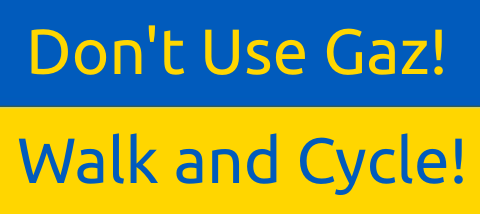
A couple who live a few doors away from me, and who have seen me coming and going on my bike, told me a few weeks ago that they were considering getting some bikes themselves. During the conversation they told me they were not willing to ride on busy roads, and would rather avoid roads altogether. That would render getting to most of Birmingham City Council's off-road routes impossible. Their stance on this is far from unusual.
Last week I was engaged in a heated discussion with someone who thought that my neighbours' stance was unreasonable and what they needed is some training. His view was that he wasn't scared of motor traffic, and that was because he had had training. Whilst I was at college I had the opportunity to get some training that would have allowed me to leap out of a light aircraft trailing a line that would operate a parachute and gently lower me back down to the ground. I didn't take the opportunity, because I am terrified of heights. Parachuting, like cycling, is far safer than one might imagine. Lots of amateurs do it every weekend. Today, one of the Red Devils, who do rather a lot of parachuting and are very well trained, suffered a parachute failure. One of his team-mates saw what had happened and went to his rescue; the two landed in some water very much alive. It was their first parachute failure in 25 years, and no-one was killed. Does knowing that parachuting is safe make me want to do it? No. The only way I would use a parachute is if the plane I was in was on fire and falling to bits in a major way (ie wings falling off).
On the other hand driving is in fact horribly dangerous, yet most people do it (including my neighbours and myself), and regularly. Most people are eager to learn to drive. They don't see driver training as a means of overcoming fear of motor traffic (or anything else), they just want to know how to operate a car sufficiently well that they can do so legally and independently. According to the American National Safety Council, you are forty times more likely to die as a result of a car crash than as a result of a cycle crash, yet most people would think cycling is the more dangerous. Quite simply, people do not have a rational approach to risk, myself included.
Relative to the general population, people who do cycle on the carriageway have an unusually high tolerance to the risk. If someone is willing to get as far as taking some training, that training may well help them, but the reality is they have an innate willingness to tolerate the perceived risk that most of the population does not have. I can honestly say that training has had no effect on my willingness to cycle because I have had no cycle training whatsoever, yet I do ride on the carriageway (though I prefer to be away from motor vehicles, as they are noisy, smelly, polluting, and potentially life-threatening). I have even ridden along what is now the hard shoulder of the M27, with trucks flying past in the next lane (at the time it was the A27, and the conversion to motorway class was going on around me). For more reasonable roads I worked out a method for cycling on busy carriageways myself. Long before John Franklin was advocating "primary position", I was engaging in something I called "controlling position"; the two are identical. Of course it wouldn't have helped me on the A27, because I can't cycle at 70mph, or even anywhere close.
However, the evidence that training does not work as a means of getting people cycling is not just anecdotal. During the sixty years of Cycling Proficiency and then Bikeability, the cycling modal share in the UK has declined to about 2% and stayed there, varying only slightly. The adults who take Bikeability and take up cycling are counterbalanced by the children who have taken Bikeability but give up cycling when they can afford their first car, a form of transport that feels safe but isn't. In the meantime the Dutch have been building cycling infrastructure, and they have achieved a modal share across the country of around 25%. In towns and cities that rises to as high as 60%. Now some will make out that the Dutch are special in some way; perhaps it's the weather, or the flatness, or even genetic (the excuses are many and novel). However, the Germans also cycle more than we do. They have a 10% modal share. In towns that have built cycling infrastructure relatively recently, such as Hilden, they have seen modal share rise from around 2% (ie the same as us) to around 20% in the time it took them to build the infrastructure. Cycling infrastructure is in fact the common feature of all the European cycling nations, and the better it is designed and built, the more people cycle.
Dutch children do have cycle training, but it is merely a part of road safety training. It's not the reason why they or anyone else cycles. People cycle when they have infrastructure that looks safe, feels safe, and takes them as quickly and directly as possible to their destination.


